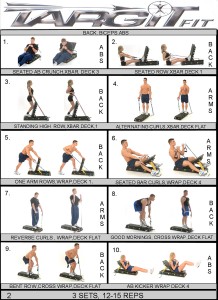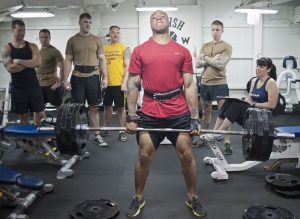Recently, we talked about losing weight and staying fit as we age. The earlier you start, of course, the better, but once you start aging, you’ll notice your body reacts differently to your workouts. Everyone is different, but typically it’s right around the 40-year mark that things start changing. You’ll notice that sore muscles last a bit longer and that you can’t increase the amount of weight you lift as much, or as often. If you’ve been lifting since your 20s, this might not be enough to discourage you. It can put a damper on your enthusiasm, though, if you’ve only been working out for a few years and suddenly develop difficulty with muscle aches and plateaus. The secret to strength training after 40 is to understand and expect the changes, and make accommodations for them.
Don’t Skip the Warm-Up

Get your blood flowing by running in place or doing jumping jacks.
Image via Jump Rope Dudes/YouTube
When you were younger and invincible, you probably did your first three sets of any given workout at about half of your maximum lift and considered it a warm-up. While a younger body can handle that, lifting light isn’t an acceptable warm-up for anyone. Warming up is supposed to do just that: warm your muscles to improve their flexibility and performance by getting the blood flowing. For those over 40, this part is vital for good muscle building workouts because, as Bodybuilding.com points out, older muscles and ligaments tighten up more and, therefore, are at a higher risk for injury. Spend 5 to 10 minutes jogging in place or on the treadmill. Alternatively, you can do 5 to 10 minutes of calisthenic-type exercises such as jumping jacks. Then spend a few minutes activating your muscles with some dynamic stretches such as leg lifts, walking lunges, arm circles and triceps stretches. Foam rollers are another effective way to warm up muscles and get blood flowing. Start every workout this way to get the most benefits of strength training without injuring yourself.
Ease Up
If you love the lift-heavy, low-rep routine you’ve been using for putting on muscle mass, it’s a good idea to back off of it once you hit 40. Whether or not you’ve recently started a strength training program, the Huffington Post recommends significantly reducing or altogether eliminating low-rep training because after 40 it’s more difficult to recover from lifting excessively heavy weights. Don’t fret that you’ll lose muscle mass. You can still maintain and even see some increases in mass by lifting moderately heavy, an amount that you max out on in eight to 12 reps. Three sets of 12 to 14 reps each are actually what personal trainers and sports specialists recommend for older lifters.
Adjust Recovery Time
You may have tried to ignore it but, after you reach a certain age, you’ll notice that it takes longer to recover from a workout. You won’t be doing yourself or your body any favors by trying to push through and forcing yourself to stick to the three days on, one day off lifting schedule you stuck to in younger days. Studies have found that taking 48 hours between training sessions is optimal for recovery. This could be structured as a one day on, one day off routine during the week that would also give you weekends off from working out. ExRx.net calls it a three day split: chest and back on Monday, legs on Wednesday and shoulders and arms on Friday. Go ahead and do extra cardio one day over the weekend if you absolutely cannot take 2 days off in a row. Just remember to give your body adequate rest and time to recover before hitting the gym again. After all, your muscles repair and grow when you’re resting, not when you’re working out. Muscle For Life even recommends taking an entire week off every 6 to 8 weeks after you hit 40.
Try Different Equipment and Workouts

TargitFit makes it easy to quickly move from one exercise to another to perform HIIT or circuit training workouts.
It can’t be denied that there’s a distinct feeling of accomplishment when you pump iron. Here’s the “but” you know is coming: free weights put a load on your joints and tendons that may cause discomfort at best, or can cause lasting injuries at worst. Since you already mastered the iron, open your mind to alternative equipment. Health professionals suggest switching to bands. They’re a safer form of resistance at any age, especially if you’ve had an injury in the past, because they don’t place a potentially dangerous load on your joints. With the right equipment, such as the TargitFit Trainer, you can do pretty much any exercise you can with free weights and all without damaging your joints and tendons. Additionally, because it’s easy to move from one exercise to the next, you can perform HIIT or circuit training workouts with the TargitFit. These types of workouts get your heart rate up, so they’re good for improving your aerobic capacity. Plus, they’re also good for muscle mass growth. According to Dr. Mercola, burst-type high-intensity exercises promote human growth hormone that encourages muscle growth.



Easier said than done..
You gotta really want it. Fitness doesn’t just happen, it takes effort and dedication. It IS easier said than done for those who go into it half-heartedly, but if you keep at it, you’ll see results.